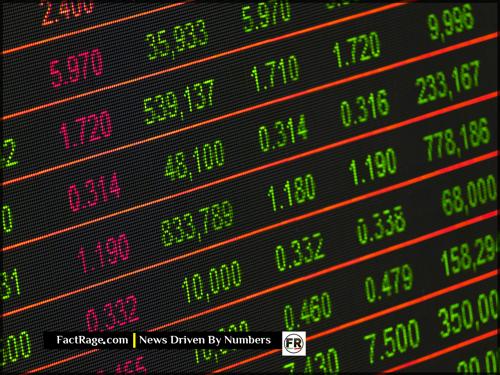NEW YORK, NY – The Dow Jones Industrial Average’s recent climb masks a significant divergence in performance among its component sectors, raising questions about the broader U.S. economic outlook for the second half of 2025.
- Sector Leadership – Technology and financial stocks are the primary drivers of the Dow’s gains, benefiting from enthusiasm for artificial intelligence and a stabilizing interest rate environment.
- Lagging Industries – Industrial and consumer staples sectors are underperforming, reflecting concerns about slowing global demand and shifts in consumer spending due to persistent, albeit moderating, inflation.
- Economic Implications – This split suggests a “two-speed” economy, where corporate and high-growth areas thrive while sectors tied to manufacturing and average consumer health face significant headwinds.
While the 30-stock index serves as a widely watched barometer for market health, its overall number doesn’t tell the full story. A closer look at the individual companies within the Dow reveals a market being pulled in two different directions, with significant implications for investors and the economy at large.
One Number, Two Economies
![]() The headline figure for an index like the Dow is often a blunt instrument, obscuring crucial details beneath its surface. True market analysis requires looking past a single data point to scrutinize the performance of its individual components. The story they tell is often far more nuanced—and ultimately, more predictive of what comes next.
The headline figure for an index like the Dow is often a blunt instrument, obscuring crucial details beneath its surface. True market analysis requires looking past a single data point to scrutinize the performance of its individual components. The story they tell is often far more nuanced—and ultimately, more predictive of what comes next.
Read On…
Here’s the data-driven analysis of which sectors are driving the market and which are being left behind, revealing the true state of the U.S. economy.
Why Tech and Financials Are Fueling the Dow’s Rise

The narrative for the first half of 2025 has been dominated by a handful of high-performing sectors, with technology leading the charge. Companies like Microsoft and Salesforce continue to see strong investor support, largely fueled by ongoing advancements and corporate investment in artificial intelligence. This AI-driven productivity boom has bolstered earnings expectations and pushed valuations higher, making the tech components of the Dow a powerful engine for growth.
At the same time, the financial sector has found its footing. With the Federal Reserve signaling a pause in its rate-hiking cycle, firms like JPMorgan Chase and Goldman Sachs are benefiting from a more predictable interest rate environment. This stability helps improve net interest margins and encourages more activity in capital markets, from mergers and acquisitions to investment banking. The performance of these financial giants has provided a secondary, powerful lift to the index.
What’s Holding Back Industrial and Consumer Stocks?
In stark contrast to the boom in tech and finance, the Dow’s industrial and consumer staples components paint a more cautious picture. Industrial bellwethers such as Caterpillar are facing headwinds from a mixed global economic forecast. A slowdown in international construction projects and softer manufacturing orders have tempered expectations, leading to sluggish stock performance. These companies, sensitive to global trade and economic cycles, reflect a broader uncertainty about worldwide growth.
Meanwhile, consumer staples—companies like Procter & Gamble and Coca-Cola that sell everyday household goods—are navigating a tricky landscape. While inflation has cooled from its peak, prices for many goods remain elevated. Data suggests some consumers are responding by shifting to lower-cost private label brands or cutting back on discretionary purchases. This pressure on sales volumes for branded goods has made it difficult for these traditionally stable stocks to keep pace with the market leaders.
What the Dow’s Internal Split Signals for the U.S. Economy
This performance gap within the Dow Jones Industrial Average is more than just a stock market phenomenon; it’s a reflection of the U.S. economy’s complex character in mid-2025. The data suggests a bifurcated or “two-speed” economy. One lane is moving fast, driven by technological innovation and healthy corporate balance sheets. The other lane is moving more slowly, weighed down by the concerns of the average consumer and the cyclical nature of global industry.
The key question this divergence raises is one of sustainability. Can a market rally led by a narrow group of sectors continue indefinitely? The health of the lagging sectors is often a better indicator of the breadth of economic prosperity. As the nation heads into the third quarter, analysts will be watching closely to see if the strength in tech and finance can pull the rest of the market up, or if the weakness in industrial and consumer-facing stocks signals a broader economic slowdown on the horizon.
The Bottom Line on This Two-Speed Market
![]() Ultimately, the Dow Jones Industrial Average is reflecting a fundamental schism in the U.S. economy. This divergence between booming, technology-forward sectors and cyclically-sensitive industries is not just a market curiosity; it is a key macroeconomic indicator to watch. As we head into the second half of the year, the crucial data points will not be the index’s headline number, but the corporate earnings and consumer health metrics that determine whether this economic divide narrows, or widens into a chasm.
Ultimately, the Dow Jones Industrial Average is reflecting a fundamental schism in the U.S. economy. This divergence between booming, technology-forward sectors and cyclically-sensitive industries is not just a market curiosity; it is a key macroeconomic indicator to watch. As we head into the second half of the year, the crucial data points will not be the index’s headline number, but the corporate earnings and consumer health metrics that determine whether this economic divide narrows, or widens into a chasm.














